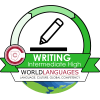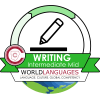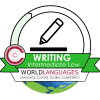Writers at the Intermediate level are characterized by the ability to meet practical writing needs, such as simple messages and letters, requests for information, and notes. In addition, they can ask and respond to simple questions in writing. These writers can create with the language and communicate simple facts and ideas in a series of loosely connected sentences on topics of personal interest and social needs. They write primarily in present time. At this level, writers use basic vocabulary and structures to express meaning that is comprehensible to those accustomed to the writing of non-natives.
 Intermediate High
Intermediate High
Writers at the Intermediate High sublevel are able to meet all practical writing needs of the Intermediate level. Additionally, they can write compositions and simple summaries related to work and/or school experiences. They can narrate and describe in different time frames when writing about everyday events and situations. These narrations and descriptions are often but not always of paragraph length, and they typically contain some evidence of breakdown in one or more features of the Advanced level. For example, these writers may be inconsistent in the use of appropriate major time markers, resulting in a loss of clarity. The vocabulary, grammar, and style of Intermediate High writers essentially correspond to those of the spoken language. Intermediate High writing, even with numerous and perhaps significant errors, is generally comprehensible to natives not used to the writing of non-natives, but there are likely to be gaps in comprehension.
 Intermediate Mid
Intermediate Mid
Writers at the Intermediate Mid sublevel are able to meet a number of practical writing needs. They can write short, simple communications, compositions, and requests for information in loosely connected texts about personal preferences, daily routines, common events, and other personal topics. Their writing is framed in present time but may contain references to other time frames. The writing style closely resembles oral discourse. Writers at the Intermediate Mid sublevel show evidence of control of basic sentence structure and verb forms. This writing is best defined as a collection of discrete sentences and/or questions loosely strung together. There is little evidence of deliberate organization. Intermediate Mid writers can be understood readily by natives used to the writing of non-natives. When Intermediate Mid writers attempt Advanced-level writing tasks, the quality and/or quantity of their writing declines and the message may be unclear.
 Intermediate Low
Intermediate Low
Writers at the Intermediate Low sublevel are able to meet some limited practical writing needs. They can create statements and formulate questions based on familiar material. Most sentences are recombinations of learned vocabulary and structures. These are short and simple conversational-style sentences with basic word order. They are written almost exclusively in present time. Writing tends to consist of a few simple sentences, often with repetitive structure. Topics are tied to highly predictable content areas and personal information. Vocabulary is adequate to express elementary needs. There may be basic errors in grammar, word choice, punctuation, spelling, and in the formation and use of non-alphabetic symbols. Their writing is understood by natives used to the writing of non-natives, although additional effort may be required. When Intermediate Low writers attempt to perform writing tasks at the Advanced level, their writing will deteriorate significantly and their message may be left incomplete.
For additional information go to

